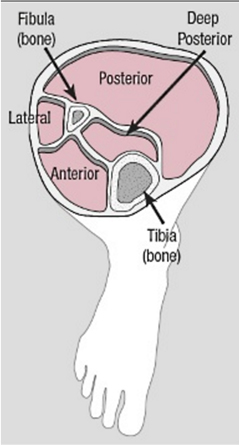
Source: http://www.uwhealth.org/files/uwhealth/images/SportsMedicine/img_compartment_syndrome.jpg
The muscles in your leg are split into compartments by fibrous tissue. For example, the anterior compartment is made up of the muscles in front of your shin bone
and all these muscles help to lift up your foot.
There is also a lateral compartment which contains the muscles on the outside of your leg, and two posterior compartments at the back of your leg (one deep and one shallow/superficial).
As well as muscles, these compartments contain blood vessels, nerves and fibrous tissue. Compartment syndrome is when the pressure within one of these compartments gets too high and causes pain. It can sometimes reduce blood flow to the area and this causes further pain (ischaemic pain). Other times it may result in numbness or difficulty moving the foot
Acute compartment syndrome is a medical emergency and is usually caused by a traumatic injury. Chronic compartment syndrome is usually related to high levels of physical activity (especially repetitive sports) and tight, overworked muscles.
Compartment syndrome pain will start at roughly the same time or distance into activity and resolve quickly once the activity is ceased.
Compartment syndrome must be differentiated from MTSS (shin splints) and DVT (deep vein thrombosis or clots) as the symptoms can be similar but the treatment can differ significantly.
Treatment from home:
- Rest from the aggravating activity
- Oral anti-inflammatory medication e.g. Ibuprofen (if this is suitable with your other medications)
Treatment from your podiatrist:
- Physical examination to differentiate from conditions that present in a similar manner
- Referral for a Stryker Inter-compartmental pressure test to confirm the diagnosis and assess the severity of the pressure levels
- Soft tissue therapy such as massage, soft tissue slow release techniques or dry needling to encourage muscle relaxation to reduce pressure in the affected compartment.
- Orthotics to Improve of foot mechanics or support the foot as it functions to reduce the stress or load on the muscles of the leg to encourage them to relax so reducing pressure and pain.

Comments are closed.